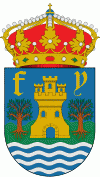Benalmádena (Benalmádena)
 |
 |
Benalmádena is rich in attractive beaches and interesting places like the Colomares Castle, the 33-metre-tall Buddhist Benalmádena Stupa, the largest Buddhist stupa in Europe, the Benalmádena Marina and the Benalmádena Cable Car.
Benalmádena covers an area of just over 27 km2 that extends from the summits of the Sierra de Mijas to the sea, falling in some places as a cliff. The territory is crossed from east to west on Highway A-7, which connects with the provincial capital and other centres of the Mediterranean coast.
With 61,383 inhabitants according to the INE census of 2010, Benalmádena is the eighth most populous municipality in the province and the third largest metropolitan area, behind Málaga and Torremolinos. The population is concentrated in three main centers: Benalmádena Pueblo, Arroyo de la Miel and Benalmádena Costa, although the high urban growth and demographic tends to unify the three cores.
Benalmádena has been inhabited since prehistoric times. Benalmádena experienced a remarkable development during the period of Muslim domination. Its development was paralyzed after joining the Crown of Castile in 1485 due to various natural disasters and the intensity of the activity of privateers in the area. The paper industry and vineyard cultivation reactivated the local economy during the 18th and 19th centuries.
In the early 21st century Benalmádena is one of the main tourist destinations on the Costa del Sol, with leisure facilities including an amusement park, two aquariums, a casino, a cable car and one of the largest marinas of Andalusia.
Historically the region has been occupied and settled by many cultures dating back to the Bronze Age, including the ancient Phoenicians and Romans, and has also been considerably influenced by the Moorish settlement of the southern Iberian peninsula. Two Almenara towers on the coastline date back to the 15th century, originally built to guard the coast and its population from the frequent incursions of Barbary pirates in the years following the reconquista (reconquest) of the region by Henry IV of Castile.
In contemporary times, along with the rest of the Costa del Sol area it has become an important tourist destination. The municipality has been subject to an unprecedented urban expansion in recent years with many new buildings and homes built, sometimes causing environmental degradation.
Benalmádena has both a traditional Spanish village and a modern, coastal, tourist area.
Map - Benalmádena (Benalmádena)
Map
Country - Spain
 |
 |
| Flag of Spain | |
Anatomically modern humans first arrived in the Iberian Peninsula around 42,000 years ago. The ancient Iberian and Celtic tribes, along with other pre-Roman peoples, dwelled the territory maintaining contacts with foreign Mediterranean cultures. The Roman conquest and colonization of the peninsula (Hispania) ensued, bringing the Romanization of the population. Receding of Western Roman imperial authority ushered in the migration of different non-Roman peoples from Central and Northern Europe with the Visigoths as the dominant power in the peninsula by the fifth century. In the early eighth century, most of the peninsula was conquered by the Umayyad Caliphate, and during early Islamic rule, Al-Andalus became a dominant peninsular power centered in Córdoba. Several Christian kingdoms emerged in Northern Iberia, chief among them León, Castile, Aragon, Portugal, and Navarre made an intermittent southward military expansion, known as Reconquista, repelling the Islamic rule in Iberia, which culminated with the Christian seizure of the Emirate of Granada in 1492. Jews and Muslims were forced to choose between conversion to Catholicism or expulsion, and eventually the converts were expelled through different royal decrees.
Currency / Language
| ISO | Currency | Symbol | Significant figures |
|---|---|---|---|
| EUR | Euro | € | 2 |
| ISO | Language |
|---|---|
| EU | Basque language |
| CA | Catalan language |
| GL | Galician language |
| OC | Occitan language |
| ES | Spanish language |
















